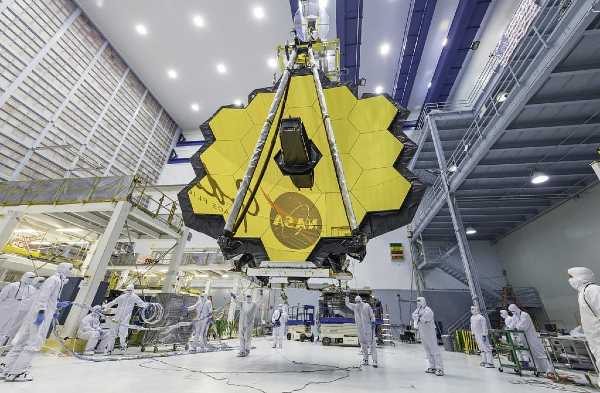The Near-Infrared Camera (NIRCam), the Near-Infrared Spectrograph (NIRSpec), the Near-Infrared Imager and Slitless Spectrograph (NIRISS), and the Mid-Infrared Instrument (MIRI) are Webb’s four scientific instruments (MIRI). Infrared detectors are used in each of these equipment to catch light from distant celestial sources.
NIRCam
Webb’s primary imager will be the Near Infrared Camera (NIRCam), which will span the infrared wavelength range of 0.6 to 5 microns. Light from the earliest stars and galaxies in the process of formation, the population of stars in adjacent galaxies, as well as young stars in the Milky Way and Kuiper Belt objects, will be detected by NIRCam.
NIRCam has coronagraphs, which are instruments that allow astronomers to photograph very faint objects surrounding a bright core source, such as star systems.
The Objective
The coronagraphs on NIRCam function by blocking the light from a brighter object, allowing you to focus on the view in front of you – just like covering your eyes from the sun with an upraised hand allows you to focus on the vision in front of you.
Astronomers intend to use the coronagraphs to detect the features of planets orbiting neighboring stars.
The University of Arizona and Lockheed Martin collaborated to create NIRCam.
NIRSpec
The NIRSpec (Near-Infrared Spectrograph) is one of the James Webb Space Telescope’s four scientific instruments (JWST). The JWST is a follow-on project to the Hubble Space Telescope (HST) that will observe infrared light from the first stars and galaxies in order to learn more about the universe’s origins.
In comparison to HST, its equipment will allow researchers to gaze further back in time, studying the so-called Dark Ages, which occurred between 150 and 800 million years after the Big Bang and during which the cosmos was opaque.
The Objective
The NIRSpec instrument is a multi-object spectrograph that can measure the near-infrared spectrum of up to 100 objects at the same time, such as stars or galaxies, with low, medium, and high spectral resolutions.
The measurements are made over a wavelength range of 0.6 m to 5.0 m in a 3 arcmin 3 arcmin field of view. It also has a set of slits and an aperture for individual source high-contrast spectroscopy, as well as an integral-field unit (IFU) for 3D spectroscopy.
The sensor is a European Space Agency (ESA) contribution, and it is built by Astrium in collaboration with a number of European subcontractors.
FGS/NIRISS
FGS-NIRISS (Fine Guidance Sensor and Near Infrared Imager and Slitless Spectrograph) is a James Webb Space Telescope (JWST) instrument that combines a Fine Guidance Sensor and a science instrument, as well as a near-infrared imager and a spectrograph.
Honeywell designed and produced the FGS/NIRISS, which was planned by the Canadian Space Agency (CSA) as part of an international collaboration with the National Aeronautics and Space Administration (NASA) and the European Space Agency to create a large infrared space telescope (ESA).
The Objective
FGS-NIRISS detects light with wavelengths ranging from 0.8 to 5.0 microns. There are four different observation modes on the apparatus.
The FGS and NIRISS are physically linked, but optically they are distinct, with the FGS being used to orient the telescope and the NIRISS being a separate science instrument. Exoplanet spectroscopy is possible with the spectroscopic mode.
According to the STSCi, the detector for NIRISS is a 2048 x 2048 pixel mercury cadmium telluride (HgCdTe) array, with each pixel measuring 18 microns on a side. The field of view is 2.2′ 2.2′, resulting in a plate scale of approximately 0.065 arcsec/pixel.
The FGS will assist the telescope in aiming and remaining pointed at whatever it is instructed to observe. [7] FGS assists the JWST Attitude Control System (ACS) by providing data, and it does so by having a large sky coverage and sensitivity, allowing it to detect a guide star with a high probability. [8]
NIRISS is made to do the following:
- Imaging in the near-infrared range.
- Slitless spectroscopy with a large field of view.
- Slitless spectroscopy of a single object.
- Interferometry using aperture masking.
A seven-hole aperture masking disc is used in the aperture masking interferometry mode, which should allow the discovery of exoplanets within particular light ranges and star types.
MIRI
The James Webb Space Telescope’s MIRI (Mid-Infrared Instrument) is a camera and spectrograph that detects infrared radiation from 5 to 28 microns in the mid-to-long wavelengths.
It also features coronagraphs, which are particularly useful for studying exoplanets.
Whereas most of the other sensors aboard Webb can see light as short as orange visible light or as far as near infrared, MIRI can sense light with greater wavelengths.
The Objective
MIRI makes observations at these wavelengths using silicon arrays doped with arsenic. The imager has a wide field of view, but the spectrograph has a narrow field of view.
It needs to be cooler than the other instruments since it sees longer wavelengths (see Infrared astronomy), hence it includes an additional cooling system.
A Pulse Tube precooler and a Joule-Thomson Loop heat exchanger are part of MIRI’s cooling system. MIRI was cooled to a temperature of 7 kelvins during space operations as a result of this.
